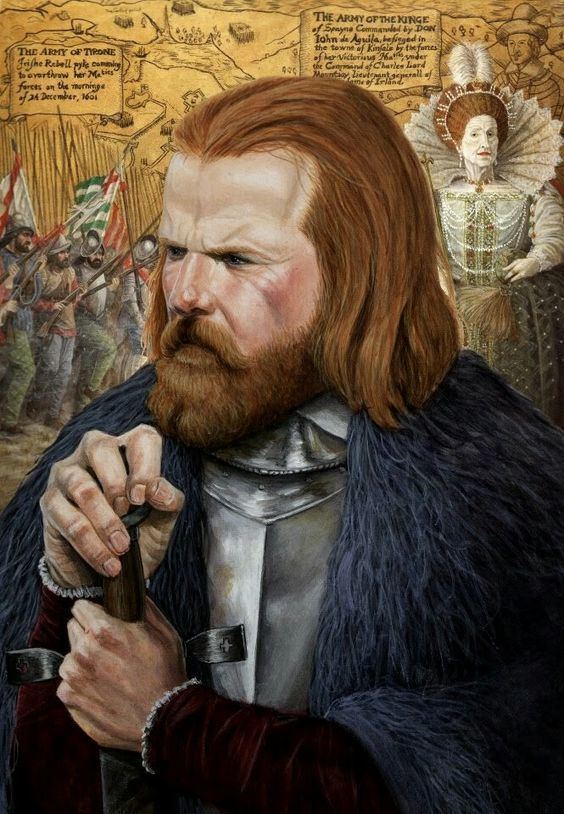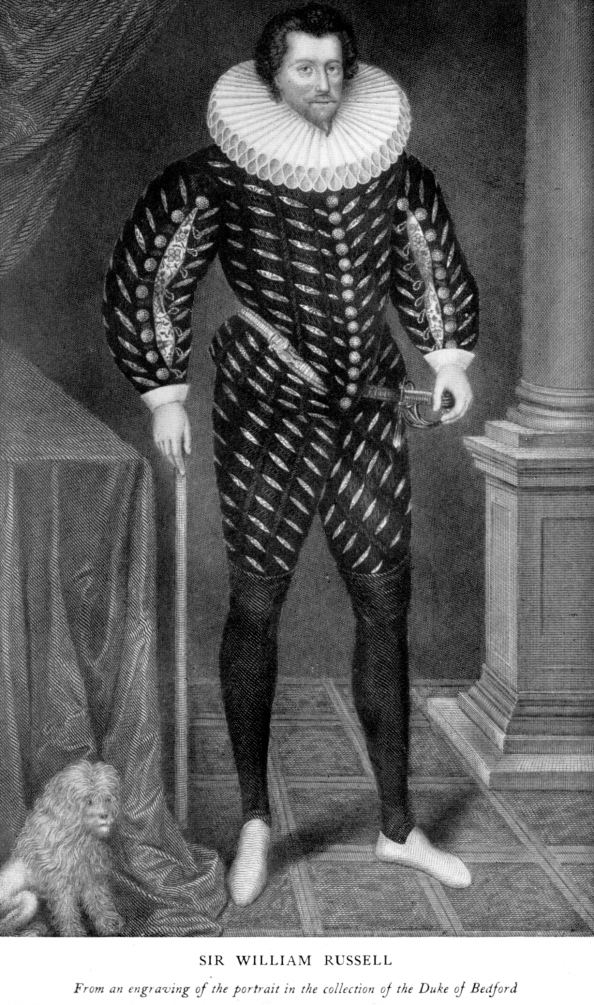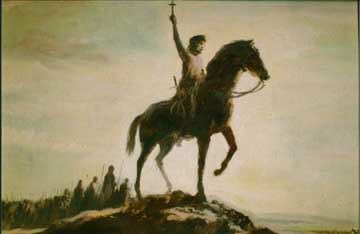Reign 1587–1602 Heir Ruairí Ó Domhnaill | Coronation 1587 Issue none | |
 | ||
Predecessor Aodh mac Maghnusa Ó Domhnaill Grandparents Manus O'Donnell, Agnes Campbell | ||
Hugh roe o donnell school boston
Hugh Roe O'Donnell (Irish: Aodh Ruadh Ó Domhnaill), also known as Red Hugh O'Donnell (30 October 1572 – 10 September 1602), was "The O'Donnell" and king of Tyrconnell. He led a rebellion against English government in Ireland from 1593 and helped to lead the Nine Years' War from 1595 to 1603. He is sometimes also known as Aodh Ruadh II or Red Hugh II, especially within County Donegal.
Contents
- Hugh roe o donnell school boston
- Early life imprisonment and escape
- The Nine Years War
- Flight to Spain and death
- Legacy
- In popular culture
- References

Early life, imprisonment, and escape
For the political context of O'Donnell's life see the Tudor conquest of Ireland

Hugh Roe O'Donnell was born to the Gaelic Lord of Tyrconnell, Sir Hugh O'Donnell, and his second wife, the Ineen Dubh, in 1572. He had numerous brothers and sisters including Donnell, Rory and Cathbarr. Sir Hugh was a long-standing ally of the Crown, in attempt to counterbalance the power of Shane O'Neill and Turlough Luineach O'Neill the rulers of neighboring Tyrone. In Sir Hugh's later years, a long-running succession dispute broke out to determine who would succeed him. Although Ineen Dubh pushed the case for Hugh Roe to succeed, it was his elder half-brother Donnell who emerged as the leading candidate. The Crown chose to support Donnell as it regarded him as the rightful and most stable potential ruler, partly due to the fact that Donnell's mother was a local woman while Hugh Roe's was from Scotland.

Donnell was strengthened by the arrival of a small detachment of Irish Army troops dispatched from Dublin under John Connill. Ineen Dubh countered this by hiring large numbers of Redshank mercenaries from her native Scotland who defeated and killed Donnell at the Battle of Doire Leathan in 1590, by which time Hugh Roe was a prisoner in Dublin. There were a number of other claimants to the O'Donnell title including Hugh Roe's great uncle Hugh Dubh O'Donnell.
At the age of fifteen, in 1587, he was seized by Sir John Perrot, then the English Lord Deputy of Ireland, and imprisoned in Dublin Castle in an attempt to prevent an alliance between the O'Donnell and O'Neill clans. O'Donnell escaped briefly in 1591 but was recaptured within days.

Hugh O'Donnell made his successful escape only in January 1592, assisted by his allies brothers Art and Hugh O'Neill, 2nd Earl of Tyrone, who arranged for his flight from Dublin into the Wicklow Mountains in the depths of winter. O'Donnell successfully reached the stronghold of Fiach McHugh O'Byrne (another of O'Neill's allies) at Glenmalure, where he found refuge, but he had lost both big toes to frostbite and his companion and fellow escapee Art O'Neill had died of exposure in the mountains. Hugh O'Donnell and his two companions, the brothers Art and Henry (Hugh) O'Neill, were the only prisoners ever to successfully escape captivity in Dublin Castle.
The Nine Years War
Upon his return to Ulster, he gained the leadership of the O'Donnell Clan becoming "The O'Donnell", Lord of Tyrconnell after his father abdicated in his favour later that year. Having driven the crown sheriff out of Tyrconnell, he successfully led two expeditions against Turlough Luineach O'Neill in 1593, to force Turlough O'Neill to abdicate his chieftainship in favour of Hugh O'Neill. At this point, O'Neill did not join O'Donnell in open rebellion, but secretly backed him to enhance his bargaining power with the English. O'Neill by now was also communicating with Philip II of Spain for military aid.
Declaring open rebellion against the English the following year, O'Donnell's forces captured Connacht from Sligo to Leitrim by 1595. In this year, Hugh O'Neill, Earl of Tyrone, abandoned negotiation with the English and in 1596 the combined forces of O'Donnell and O'Neill defeated an English army under Sir Henry Bagenal at the Battle of Clontibret.
Their greatest victory came two years later however at Battle of the Yellow Ford on the Blackwater River near the southern border of Tyrone in August 1598. At this battle, the Irish annihilated an English force marching to relieve Armagh and they seemed on the verge of expelling the English from Ireland altogether.
O'Neill then went south to secure the allegiance of Irish lords in Munster, without much success. O'Donnell raided Connacht, destroying the town of Athenry, laying waste to much of County Galway, and on being refused entry to Galway, burned its suburbs:
"... he sent forth swift-moving marauding parties through the district of Caladh, and the upper part of the territory; and they carried off many herds of cows and other preys to O'Donnell, to the town of Athenry; and though the warders of the town attempted to defend it, the effort was of no avail to them, for O'Donnell's people applied fires and flames to the strongly-closed gates of the town, and carried to them great ladders, and, placing them against the walls, they recte, some of them ascended to the parapets of the wall. They then leaped from the parapets, and gained the streets of the town, and opened the gates for those who were outside. They all then proceeded to demolish the storehouses and the strong habitations; and they carried away all the goods and valuables that were in them. They remained that night in the town. It was not easy to enumerate or reckon the quantities of copper, iron, clothes, and habiliments, which they carried away from the town on the following day. From the same town he sent forth marauding parties to plunder Clanrickard, on both sides of the river; and these marauders totally plundered and ravaged the tract of country from Leathrath to Magh-Seanchomhladh. The remaining part of his army burned and ravaged the territory, from the town of Athenry and Rath-Goirrgin Westwards to Rinn-Mil and Meadhraige, and to the gates of Galway, and burned Teagh-Brighde, at the military gate of Galway".
As a result of these and other assaults, O'Donnell was unable to persuade the local lords to join him.
However, in the next two years, O'Donnell and O'Neill were hard pressed with the deployment of thousands more English troops in the country. O'Donnell repulsed an English expedition towards western Ulster at the Battle of Curlew Pass in 1599, but his and O'Neill's position was increasingly defensive. Even worse for O'Donnell than English offensives was the defection of his kinsman {cousin and Brother-in-law}, Niall Garve O'Donnell to the English side, in return for their backing his own claim the O'Donnell chieftainship. Niall Garve's brothers and hundreds of followers also joined him in supporting the Crown. Hugh Roe was so outraged by this, that he killed Niall Garve's infant son (and his own nephew) by beating him to death. Niall Garve's support allowed the English to land a seaborne force at Derry in the heart of O'Donnell's territory and win the O'Donnell stronghold of Lifford in the Battle of Lifford. O'Donnell led an unsuccessful Siege of Donegal, the garrison of which was commanded by Niall Garve.
They recognised that their only chance of winning the war outright was with the aid of a Spanish invasion. The Spanish finally landed at Kinsale – at virtually the opposite end of Ireland from the Ulster rebels in September 1601. O'Donnell Led his army in a hard march during the winter of 1601, often covering over 40 miles a day, to join O'Neill and the Spanish General Juan del Águila at Kinsale arriving in early December 1601.
En route, true to his family arms and Constantinian motto In Hoc Signo Vinces and in anticipation of the battle to come at Kinsale, he visited and venerated a supposed relic of the True Cross (Holy rood) on the Feast of St. Andrew, on 30 November 1601 at Holy Cross Abbey, and removed a portion of it. From there he sent an expedition to Ardfert in County Kerry, to win a quick victory and successfully recover the territory of his ally, Fitzmaurice, Lord of Kerry, who had lost it and his 9-year-old son, to Sir Charles Wilmot. He left some of his O'Donnell kinsmen behind in Ardfert to guard the Barony of Clanmaurice, notably his first cousin and nephew, Domhnall Oge, son of his half-brother, Sir Domhnall O'Donnell, and who appears in the FitzMaurice pardon of 16 July 1604.
During the Battle of Kinsale on 5/6 January 1602 the combined forces of Del Águila, O'Neill and O'Donnell were defeated by Sir Charles Blount, Lord Mountjoy.
Flight to Spain and death
After the Irish defeat at Kinsale, O'Donnell left Ireland and sailed to Corunna in Galicia, Spain, where many other chieftains were already arriving with their families. There he was received with great honours by the Governor of Galicia and the Lord Archbishop of Santiago de Compostela, where an Irish College was founded. He was also taken to "visit the Tower of Betanzos, where according to bardic legends the sons of Milesius left to the IsIe of Destiny".
While based in Corunna, he plotted a return to Ireland and travelled to Valladolid to ask further assistance from Philip III of Spain, who promised him he would organise a new invasion of Ireland. As a year passed and O'Donnell did not receive any news from Philip III of Spain, he left again for Valladolid but he died en route and was buried at Simancas Castle in 1602. He was attended on his death-bed by Archbishop of Tuam Fláithrí Ó Maol Chonaire and two friars from Donegal named Father Muiris mac Donnchadh Ulltach and Father Muiris mac Seaán Ulltach.
The Anglo-Irish double-agent, James "Spanish" Blake, is alleged to have poisoned O'Donnell. The Calendar of the Carew Manuscripts, preserved in the Archepiscopal Library at Lambeth, 1601–1603, was copied and published in 1870 by Longmans, Green & Co. in London detailing the official preserved letters from Sir George Carew, President of Munster during part of the Nine Years' War, to Charles Blount, Lord Mountjoy, who was nominated as Lord Lieutenant over Ireland by Queen Elizabeth I. Some of these letters were written in cipher, but the key to the cipher was to use a substitute letter six spaces earlier in the alphabet. In the letter from Carew to Mountjoy dated 28 May 1602, Carew reported to Mountjoy "One James Blake...took a solemn oath to do service...and is gone into Spain with a determination (bound with many oaths) to kill O'Donnell", and then another letter, written partially in cipher, was sent from Carew to Mountjoy dated 9 October 1602, "O'Donnell is dead... he is poisoned by James Blake, of whom your lordship hath been formerly acquainted...". With his death Spanish plans to send further assistance to the Irish were abandoned.
He was buried in the chapter of the Franciscan monastery in Valladolid. The building was demolished in the nineteenth century, and the exact location of the tomb is unknown. Thomas McGreevy's poem Aodh Ruadh Ó Domhnaill describes a search for his grave:
Juan de Juni, the priest said,Each J becoming H,Berruguete, he said,and the G was aspirate,Ximénez, he said thenAnd aspirated first and last.But he never saidAnd -- it seemed odd -- heNever had heardThe aspirated nameOf the centuries-deadBright-haired young manWhose grave I sought.McGreevy describes how, when
They broughtHis blackening bodyHereTo restPrinces cameWalkingBehind itAnd all Valladolid knew
And out to Simancas all knew
Where they buried Red Hugh.
Aodh was succeeded as chief of the Clan O'Donnell by his brother, Rory O'Donnell, created the 1st Earl of Tyrconnell the following year by the English Crown. Rory succeeded Red Hugh as both King of Tír Chonaill and leader of the Red Hugh O'Donnell faction within the divided dynasty. His sister Nuala O'Donnell was married to his kinsman and rival Niall Garve O'Donnell
Legacy
He was highly praised in the Irish language writings of the early seventeenth century for his nobility and religious commitment to the Catholic faith – notably in the Annals of the Four Masters and Beatha Aodh Ruadh Ó Domhnaill ("The Life of Red Hugh O'Donnell") by Lughaidh Ó Cléirigh. Although his posthumous reputation has been somewhat overshadowed by that of his ally Hugh O'Neill, his leadership and military capabilities were considerable, especially considering that he was active at a very young age and only 29 years old at the Battle of Kinsale. His personality seems to have been particularly magnetic, and contemporary sources are united in their praise of his oratorical ability.
In 1843 Michael Joseph MacCann wrote the song "O'Donnell Abu" in tribute, drawing on the tradition of romantic nationalism which was popular during the era.
In 1977, the Aodh Ruadh O Domhnaill Guild was formed to seek his recognition as a saint of the Catholic Church.
In 1991, a plaque was erected at Simancas Castle in commemoration of Red Hugh O'Donnell.
In 1992, commemorating the 390th anniversary of the arrival of O'Donnell in Galicia, the Grammy-award-winning composer of Riverdance, Bill Whelan, brought together musicians from Ireland and Galicia and released the symphony From Kinsale to Corunna.
In September 2002 Eunan O'Donnell, BL, gave the Simancas Castle Address in honour of Red Hugh, during the O'Donnell Clan Gathering to Spain.
